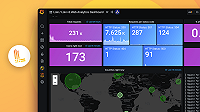Important: This documentation is about an older version. It's relevant only to the release noted, many of the features and functions have been updated or replaced. Please view the current version.
Configure monitoring and alerting
By default this Helm Chart configures meta-monitoring of metrics (service monitoring) and logs (self monitoring). This topic will walk you through configuring monitoring using a monitoring solution local to the same cluster where Loki is installed.
The ServiceMonitor resource works with either the Prometheus Operator or the Grafana Agent Operator, and defines how Loki’s metrics should be scraped. Scraping this Loki cluster using the scrape config defined in the SerivceMonitor resource is required for the included dashboards to work. A MetricsInstance can be configured to write the metrics to a remote Prometheus instance such as Grafana Cloud Metrics.
Self monitoring is enabled by default. This will deploy a GrafanaAgent, LogsInstance, and PodLogs resource which will instruct the Grafana Agent Operator (installed seperately) on how to scrape this Loki cluster’s logs and send them back to itself. Scraping this Loki cluster using the scrape config defined in the PodLogs resource is required for the included dashboards to work.
Rules and alerts are automatically deployed.
Before you begin:
- Helm 3 or above. See Installing Helm.
- A running Kubernetes cluster with a running Loki deployment.
- A running Grafana instance.
- A running Prometheus Operator installed using the
kube-prometheus-stackHelm chart.
Prometheus Operator Prequisites
The dashboards require certain metric labels to display Kubernetes metrics. The best way to accomplish this is to install the kube-prometheus-stack Helm chart with the following values file, replacing CLUSTER_NAME with the name of your cluster. The cluster name is what you specify during the helm installation, so a cluster installed with the command helm install loki-cluster grafana/loki would be called loki-cluster.
kubelet:
serviceMonitor:
cAdvisorRelabelings:
- action: replace
replacement: <CLUSTER_NAME>
targetLabel: cluster
- targetLabel: metrics_path
sourceLabels:
- "__metrics_path__"
- targetLabel: "instance"
sourceLabels:
- "node"
defaultRules:
additionalRuleLabels:
cluster: <CLUSTER_NAME>
"kube-state-metrics":
prometheus:
monitor:
relabelings:
- action: replace
replacement: <CLUSTER_NAME>
targetLabel: cluster
- targetLabel: "instance"
sourceLabels:
- "__meta_kubernetes_pod_node_name"
"prometheus-node-exporter":
prometheus:
monitor:
relabelings:
- action: replace
replacement: <CLUSTER_NAME>
targetLabel: cluster
- targetLabel: "instance"
sourceLabels:
- "__meta_kubernetes_pod_node_name"
prometheus:
monitor:
relabelings:
- action: replace
replacement: <CLUSTER_NAME>
targetLabel: clusterThe kube-prometheus-stack installs ServicMonitor and PrometheusRule resources for monitoring Kubernetes, and it depends on the kube-state-metrics and prometheus-node-exporter helm charts which also install ServiceMonitor resources for collecting kubelet and node-exporter metrics. The above values file adds the necessary additional labels required for these metrics to work with the included dashboards.
If you are using this helm chart in an environment which does not allow for the installation of kube-prometheus-stack or custom CRDs, you should run helm template on the kube-prometheus-stack helm chart with the above values file, and review all generated ServiceMonitor and PrometheusRule resources. These resources may have to be modified with the correct ports and selectors to find the various services such as kubelet and node-exporter in your environment.
To install the dashboards:
Dashboards are enabled by default. Set
monitoring.dashboards.namespaceto the namespace of the Grafana instance if it is in a different namespace than this Loki cluster.Dashbards must be mounted to your Grafana container. The dashboards are in
ConfigMaps namedloki-dashboards-1andloki-dashboards-2for Loki, andenterprise-logs-dashboards-1andenterprise-logs-dashboards-2for GEL. Mount them to/var/lib/grafana/dashboards/loki-1and/var/lib/grafana/dashboards/loki-2in your Grafana container.Create a dashboard provisioning file called
dashboards.yamlin/etc/grafana/provisioning/dashboardsof your Grafana container with the following contents (note: you may need to edit theorgId):--- apiVersion: 1 providers: - disableDeletion: true editable: false folder: Loki name: loki-1 options: path: /var/lib/grafana/dashboards/loki-1 orgId: 1 type: file - disableDeletion: true editable: false folder: Loki name: loki-2 options: path: /var/lib/grafana/dashboards/loki-2 orgId: 1 type: file
To add add additional Prometheus rules:
Modify the configuration file
values.yaml:monitoring: rules: additionalGroups: - name: loki-rules rules: - record: job:loki_request_duration_seconds_bucket:sum_rate expr: sum(rate(loki_request_duration_seconds_bucket[1m])) by (le, job) - record: job_route:loki_request_duration_seconds_bucket:sum_rate expr: sum(rate(loki_request_duration_seconds_bucket[1m])) by (le, job, route) - record: node_namespace_pod_container:container_cpu_usage_seconds_total:sum_rate expr: sum(rate(container_cpu_usage_seconds_total[1m])) by (node, namespace, pod, container)
To disable monitoring:
Modify the configuration file
values.yaml:selfMonitoring: enabled: false serviceMonitor: enabled: false
To use a remote Prometheus and Loki instance such as Grafana Cloud
Create a
secrets.yamlfile with credentials to access the Grafana Cloud services:--- apiVersion: v1 kind: Secret metadata: name: primary-credentials-metrics namespace: default stringData: username: "<instance ID>" password: "<API key>" --- apiVersion: v1 kind: Secret metadata: name: primary-credentials-logs namespace: default stringData: username: "<instance ID>" password: "<API key>"Add the secret to Kubernetes with
kubectl create -f secret.yaml.Add a
remoteWritesection toserviceMonitorinvalues.yaml:monitoring: ... serviceMonitor: enabled: true ... metricsInstance: remoteWrite: - url: <metrics remote write endpoint> basicAuth: username: name: primary-credentials-metrics key: username password: name: primary-credentials-metrics key: passwordAdd a client to
monitoring.selfMonitoring.logsInstance.clients:monitoring: --- selfMonitoring: enabled: true logsInstance: clients: - url: <logs remote write endpoint> basicAuth: username: name: primary-credentials-logs key: username password: name: primary-credentials-logs key: password lokiCanary: enabled: falseInstall the
Loki meta-motoringconnection on Grafana Cloud.



